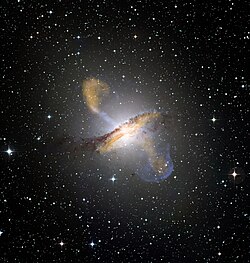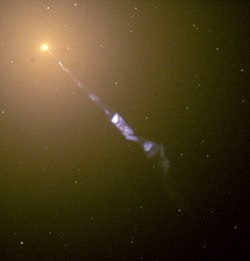
An astrophysical jet is an astronomical phenomenon where ionised matter is expelled at high velocity from an astronomical object, in a pair of narrow streams aligned with the object's axis of rotation. [1] When the matter in the beam approaches the speed of light, astrophysical jets become relativistic jets (see below) as they show effects from special relativity.
Contents
- Relativistic jets
- Rotation as possible energy source
- Relativistic jets from neutron stars
- Other images
- See also
- References
- External links
Astrophysical jets are associated with many types of high-energy astronomical sources, such as black holes, neutron stars and pulsars. Their causes are not yet fully understood, but they are believed to arise from dynamic interactions within accretion disks. One explanation is that as an accretion disk spins, it generates a rotating, tangled magnetic field which concentrates material from the disk into the jets and then drives it away from the central object. [2] Jets may also be influenced by a general relativity effect known as frame-dragging. [3]
Most of the largest and most active jets are created by supermassive black holes (SMBH) in the centre of active galaxies such as quasars and radio galaxies or within galaxy clusters. [4] Such jets can exceed millions of parsecs in length. [2] Other astronomical objects that produce, or are caused by, jets include cataclysmic variable stars, X-ray binaries and gamma-ray bursts (GRB). Jets on a much smaller scale (~parsecs) may be found in star forming regions, including T Tauri stars and Herbig–Haro objects; these objects are partially formed by the interaction of jets with the interstellar medium. Bipolar outflows may also be associated with protostars, [5] or with evolved post-AGB stars, planetary nebulae and bipolar nebulae.







